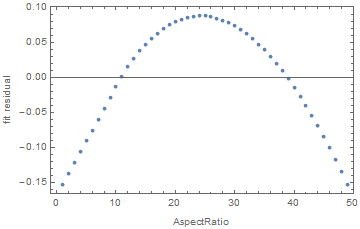Let us examine the agreement between specified value for the AspectRatio option and the actual aspect ratio of generated plot. For this purpose I define a function which uses the Rasterize trick for determination of the actual aspect ratio:
realAspectRatio = #2/#1 & @@ (#2 - #1) & @@
Rasterize[
Show[#, Epilog -> {Annotation[
Rectangle[ImageScaled[{0, 0}], ImageScaled[{1, 1}]], "Two",
"Region"]}], "Regions"][[-1, 2]] &;
(Instead of realAspectRatio@ one can use much more basic but lesser precise function #2/#1 & @@ ImageDimensions@ what gives the same results.)
At first, we check the agreement for simple graphics Graphics[{Point[{{0, 0}, {1, 1}}]}]:
table = Table[{10^p, realAspectRatio@
Graphics[{Point[{{0, 0}, {1, 1}}]}, AspectRatio -> 10^p]}, {p, -2, 2, .1}];
lm = LinearModelFit[table, x, x];
lm["BestFit"]
ListPlot[lm["FitResiduals"], Frame -> True,
FrameLabel -> {"AspectRatio", "fit residual"}]
1.26421 + 0.603143 x
One can see that actual aspect ratio substantially differs from the requested via the AspectRatio option and the dependence between them is nonlinear!
In this case the situation becomes MUCH better if we provide at least horizontal PlotRange specification PlotRange -> {{0, 1}, Automatic}:
table = Table[{10^p,
realAspectRatio@
Graphics[{Point[{{0, 0}, {1, 10}}]}, AspectRatio -> 10^p,
PlotRange -> {{0, 1}, Automatic}]}, {p, -2, 2, .1}];
lm = LinearModelFit[table, x, x];
lm["BestFit"]
ListPlot[lm["FitResiduals"], Frame -> True,
FrameLabel -> {"AspectRatio", "fit residual"}]
0.00391481 + 1.00225 x
But for a little more complex graphics ListPlot[Prime[Range[25]]] this remedy does not help even if we vary AspectRatio in much lesser diapason from 1/5 to 5:
table = Table[{ar, realAspectRatio@
ListPlot[Prime[Range[25]], PlotRange -> {{0, 25}, {0, 100}},
AspectRatio -> ar]}, {ar, 1/5, 5, .1}];
lm = LinearModelFit[table, x, x];
lm["BestFit"]
ListPlot[lm["FitResiduals"], Frame -> True,
FrameLabel -> {"AspectRatio", "fit residual"}]
0.248369 + 0.768459 x
How this behavior can be explained? Is it intended behavior? And more importantly: is there a way to make the actual aspect ratio predictable?
Summary of the discussion and the conclusion
The source of confusion was the first sentence under the "Details" section on the Documentation page for AspectRatio: "AspectRatio determines the scaling for the final image shape." This statement is clearly wrong and more correct statement can be found as the first point under the "Properties and Relations" subsection in the "Examples" section on the same page: "AspectRatio determines the ratio of PlotRange, not ImageSize." But as it is clearly demonstrated in dedicated answer, even this statement is not precise because actually AspectRatio determines the aspect ratio of the plotting area which is specified by both PlotRange and PlotRangePadding.






ScalednotImageScaledcorrectly place aRectanglealigned with the range of the plot therefore any calculations based on these are inaccurate. Edit: I forgot aboutPlotRangePadding. With that set to zero the rectangle aligns. $\endgroup$#2/#1 & @@ ImageDimensions@instead ofrealAspectRatio@I get roughly the same picture. I'm surprised thatImageScaledworks incorrectly because my little experimentation with plots in the question showed correct behavior ofrealAspectRatio. $\endgroup$